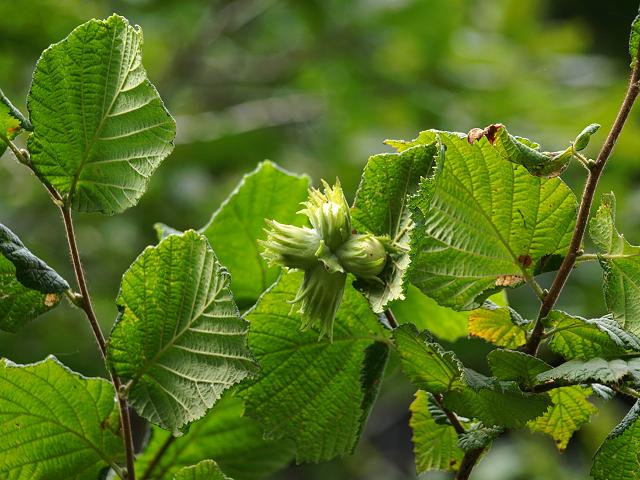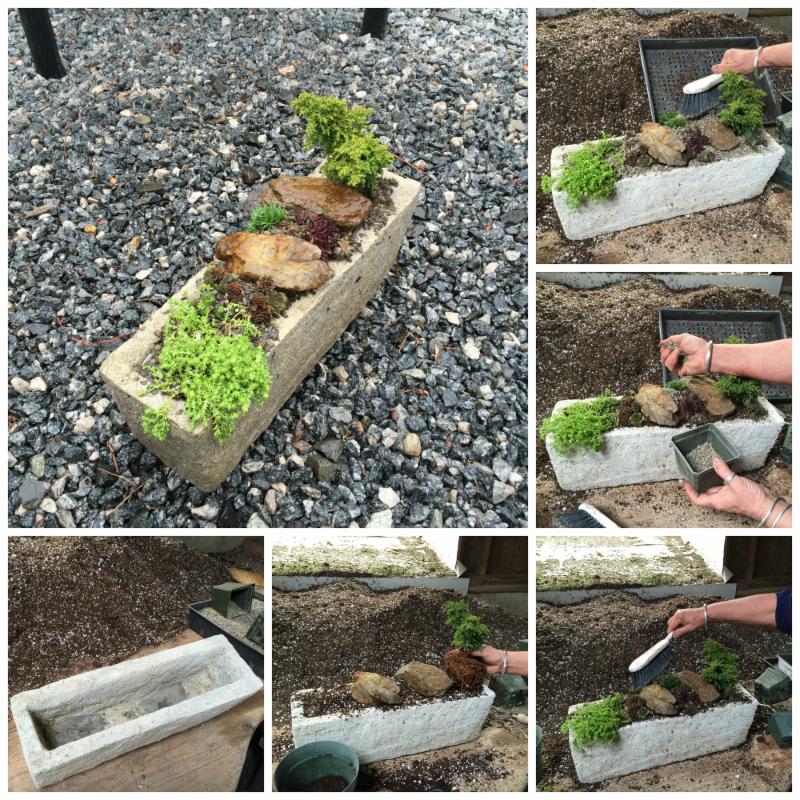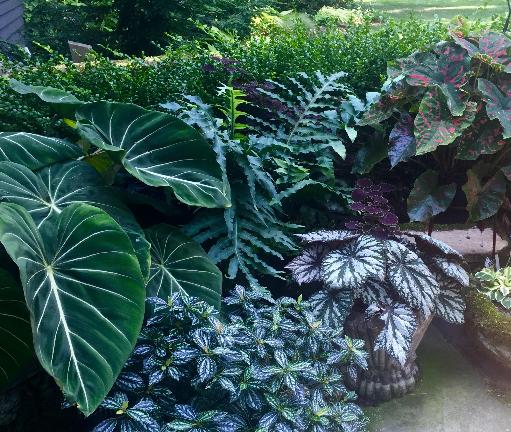|
Plant Spotlight: Corylus avellana (European Filbert)
By Vinny LoVerme
Most everyone knows of Corylus avellana 'Contorta', more commonly known as the Contorted Filbert, or Harry Lauders Walking Stick. It has been popular because of it's gnarly stems and crinkled leaves, which can add intriguing texture to the garden and winter interest. Though we always have a couple beautiful specimens for sale for those of you who need a key feature in the garden, we will also be carrying other less common varieties of European Filbert, those that have been selected for their nut production, that's right, more specifically filbert production! If you never knew, Harry Lauders Walking Stick was found in England as a sport in a hedge of the straight species, which was probably planted for its nut production.
Corylus avellana grows anywhere from 12 to 20' in height into an attractive large shrub or small tree. The leaves are simple, 2-4" long, have a nice dark green color and turn to a yellowy-green in fall. They require full sun or part shade and a moist, well drained, loamy soil, and are hardy to zone 4. They are monoecious, which means each plant contains both male and female flowers. The male catkins are formed in autumn and don't open until early spring. They range from 1 1/2 - 3" long, are yellow-green, and can be quite attractive all winter long. The female flowers are small and are a rich red color. Even though they are somewhat inconspicuous, upon close inspection are quite pretty. These female blossoms form the nuts that are most often referred to as filberts, or hazelnuts. These are about 3/4" long, and are enclosed in an involucre or husk that is downy and deeply notched, and mature in September to October. They are relished by wildlife, and of course, humans, are packed with healthy fats, vitamins, and minerals, and can be eaten raw, roasted, or used in dishes and desserts.

There is all sorts of research being done on this species right now to create improved varieties because of their abounding benefits. Some people feel they are the perfect candidate for woody sustainable agriculture. Unlike most conventional crops in agriculture, hazelnuts protect the soil from erosion, grow where annual row crops cannot be planted, reduce chemical inputs, help purify the air by carbon sequestration in their roots, provide habitat for wildlife, and produce a healthy and delicious nut. There are several organizations working to hybridize C. avellana and C. americana, the American Hazelnut, in order to create improved varieties that can be used in woody agriculture. The Arbor Day Foundation has teamed up with Oregon State University, Rutgers University, and the University of Nebraska-Lincoln to form the Hybrid Hazelnut Consortium. Their goal is to develop hazelnuts that are more adaptable and better yielding, to provide a low input, sustainable crop that addresses the worlds critical issues related to food, livestock feed, and bio-energy.
We are carrying two excellent cultivars of C. avellana this year, 'Eta' and 'Yamhill', both in respectable sizes. You should know that more than one variety is needed for good pollination and nut production, and because they are wind pollinated, should be planted no more than 20 meters apart. So why not plant a small tree or large shrub that is both ornamental and productive? They can be used in groupings, worked into shrub borders, perhaps a hedge, or better yet, how about a small orchard.
|

So You Want to Enter a Flower Show.... By Lori Chips
In recent years more & more of our customers have become interested in entering their plants in flower shows. I can only view this as a positive thing. Our customers come in, freshly inspired to create a special trough, a succulent bowl, even a planted wall to wow the competition. For years I have been reading the British rock garden journals, drooling over their show plants, learning from their techniques and at times plain old envious of their abilities. (Of course, those abilities often include an Alpine House, a more forgiving climate and deep pockets...) Anyway it seems, in our neck of the woods at least, more of us are willing to enter the fray. And let me say, right off the bat, that this should be FUN. It is a learning curve, and newcomers should enjoy the journey. It ought to enhance your gardening life, not stress you out. So in the spirit of ditching the stress I thought I might share what I have learned over the years while helping many of you prepare your offerings, research botanical names, figure out what the judges are looking for. At the extreme (and obvious) top of the list is: Understand your Show Schedule. Keep a copy with you while you shop or talk with people in the business and plan. For those new to this, the Show Schedule is not a calendar of events (though that information may be included.) It is first and foremost a set of show rules. Without adhering to these you stand no chance of placing let alone winning anything. And it is frustrating to even enter the competition when you have not gotten your mind around the categories, classes, and restrictions. If you are entering a show as part of a garden club you will be ahead of the game in several ways. The camaraderie will help spur you on, usually the club has already decided on which category you will enter, so that's done, and ta-da! the biggie: there is BOUND to be a seasoned show winner in your midst! Take advantage of this to ask advice. Of course, don't expect her to show all her cards. She is a winner for a reason. She may not mention a secret source of plants or containers, her backyard plunge frames, or other tricks she uses. But I am sure even the most competitive reigning winner will take the time to help compatriots (better your club wins than another, and the idea of a "sweep" is sweet!) And do not discount the pervasive innate generosity of gardeners. We all like to share stuff, whether it is knowledge or actual living plant material. Speaking of material, there is almost always a minimum time period before the show that you need to own the plants. This should be one of the first things you check on as you plan to go forward. I do realize that participants have no control over when the schedule comes out and when the show will be held. But please keep in mind that the availability of plants is highest in the spring, when the best choices are to be had. Many gorgeous species cannot be had for love or money once the crop has run out. In the realm of alpines, one tactic that seasoned show participants use is to have several troughs established at home, even a crevice garden or small scale rock garden from which to draw. Some things can be lifted, some divided, some succulents can be "pupped." Simply stated, that is removal of offsets or rosettes to be rooted in a new container. Many people purchase a few extras in the spring for this eventuality, sedums and sempervivums being prime candidates as they are very forgiving. Again, be aware that propagating plants in fall and winter is not often a resounding success, we are subject to the laws of nature on this point, renewal of the growth cycle is the optimal time. From your show schedule you will learn the type of container allowable. Since I am in Alpines (surprise!) let's just call that a trough. Figure out the dimensions the judges want, and whether the trough is measured from rim to rim INSIDE or OUTSIDE the walls. Woe is the intrepid competitor who loses, literally, by an inch. Or a centimeter. Remember that the height may matter too. Height always matters in the cultivation of these gems, the deeper the better for longevity. So once you container is made, borrowed or bought, look at the plants they want to see. Is this a competition based on hardy plants? That means winter hardy in our area, and that means do not include annuals, tropicals or non-hardy material. If it is a succulent class the choice may be up to you, but do not mix the two. I have listened to downcast club members who have lost for including one echeveria among the alpines. (Not to besmirch the non-hardies, an alpine among the echeverias would be equally disqualified.) The same rules apply to shade and sun plants, do not mix these in the same container. I am not certain that most judges know which plants might prefer wet feet or xeric conditions in every case but if you know the difference it makes sense to obey that too. You would not try to grow a pitcher plant and a cactus together though, of course, not every pairing will be as obvious as that. Other questions to be sure about: in an alpine category, do the judges mean true alpines from above timberline? Or perhaps the looser sense of alpines applies, using things in proper scale. Scale, by the way, can make or break your mini landscape. A 5 inch iris, though dwarf, will not be in scale when used with a 7 inch conifer. Pay attention to the size of leaves as well, the tinier ones enhance believability. The schedule will also tell you how many species you must include. Species means the second name, by the way: Aquilegia jonesii and Aquilegia scopulorum are two different species, so they count. A huge advantage when designing a trough is to have a fabulous collection of rocks. Rounded ones do not "design" well. The more craggy and angular, the more dramatic the result. Stick with one kind of stone per container, be it slate, tufa, granite, sandstone, or scoria. Become a little bit of a rock collector. On hikes, or around your yard keep a lookout for handsome specimens, and when you need to, don't reject the idea of buying stone. Stone yard people are very friendly I have found, talk with them and see if they will sell small quantities and allow you to hand pick a selection. A pitfall I often see with stone used in troughs is choosing only small pieces. Your container can have layers and "sandwiches" of stone much bigger than you might think; it adds dimension and often height. It can help in creating multiple levels in your trough, always an arresting feature. 
Plant up the trough in reasonable time to let it get established if you have the luxury of that. Realize that any perlite in the soil mix can and will tend to "float" up onto the mulch. Best to have time to handle this. Don't be afraid to prune any woody material either. Take a page from the Bonsai artists. Limb up your little tree. Or carve out a small cave beneath to show off the trunk from a choice angle. I recommend working with the pruning before planting the shrub because it is only after pruning you will find the most enchanting angle to feature. Use small tools for pruning, even cosmetic scissors. Go slow. I once snipped off a third of a rare budded alpine Lupine just before we at NYBG entered the Rockefeller Center Flower Show. I was moving too fast and want never to feel that sickening feeling again. But if the worst happens, almost always something can be done. Even if it means consigning the mistake to a home project till it grows some more and finding a replacement. This isn't life and death, it's gardening, just get creative. Water the container well the day before transporting it. That means: until water comes out of the drainage hole. Also this is a great time to groom the plants pretty carefully. The Judges will be looking at things closely, you should too. Grooming is even listed as earning points in some situations. The next day pack your entry carefully for the trip to the venue. Keep it from sliding or moving in the car. Use whatever works, boxes, bubble wrap, an old pillow or two. Leave these in the car for the ride home by the way. And bring along some supplies, an emergency kit if you will. Include those little nail scissors, plus a container of extra mulch to use to top things up. A little watering can might prove helpful; get one with a rose so it will not disturb the mulch. And though this might sound silly, bring along a soft small paintbrush to sweep away any noticeable particles that could distract from your design. A soft brush will not harm the plants and can be used right on top of cushion plants, in the crevices of the tree trunks and inside all the cracks in the stones that tend to hold on to perlite or soil. Labeling! A vastly important element. I like to clip & insert labels near each plant and closest to a rock or trough edge, and push them in till they are just below the mulch. If that is not your style, make a thumbnail map of the trough & write the names in. Keep your labels too, as a reference. You may want these back next to the plants once your container comes home. And as always, when a toddler/pet/neighbor/squirrel has removed the labels before you had a chance to record things I will be here, of course, ready to help you figure things out....
|

The Power of One
By Andrea Busk
One aspect to my life as a gardener that continually surprises me is the extent to which my design aesthetic evolves over time. When I began gardening I was all about the flowers and pretty cottage garden designs - lots of petunias, verbenas and salvias with the corresponding silver or chartreuse to set off the flowers. Now I definitely favor architectural forms and textures in my designs - the large, fuzzy leaves of Tibochina grandiflora, the statuesque Cyperus 'King Tut' or any one of the cool succulents we carry. Recently, and quite unexpectedly, I felt a shift in my love for the mixed container. I found myself leaning more towards the idea of designing with multiple containers. One pot, one plant - arranged with others in a complementary fashion. Now, I know I spend the better part of my container designing efforts at the Nursery creating mixed containers both for display and for our customers. It's hard to resist all the colors and textures that the annual world has to offer and not get caught up with how incredibly one plant's color or texture compliments another. Too much temptation and little restraint lead me to design mixed container after mixed container. And the results are generally good - most of the time or at least for the first half of the growing season when all the plants are playing fair. There are, however, always those few containers where by the end of the season (despite my best pruning efforts) one or more of those plants have completely overwhelmed the pot and grown wonky simply because the plants did not have enough room. But then, last spring, my appreciation of the mixed container unexpectedly began to shift. Each spring I bring outside the plants I deemed worthy of my attention over the winter. Usually I find homes for these plants in the garden or in other containers, but last year I simply ran out of time and hurriedly just shoved a bunch of these plants, each in their own container, together in complementary groups. One of my biggest gardening joys is when serendipity creates a 'wow' moment in the garden. Those times when we haven't designed it and yet it comes out better than we could have designed it. Does that make sense? Well I hope so because those containers each with one plant, having ample room to grow and flourish, had grown into one of the easiest and most stunning container designs I had ever done. A gorgeous architectural Philodendron Gloriosum, Blue Star Fern, a silver,green and red rex Begonia and a bright, silver-veined Pilea cadierei all individually rewarded me with masses of texture and a stunning array of grays, blues and silvers. And the best part of it all was how easy it was to keep everything looking great. None of the plants needed pruning, they grew large and healthy, watering was a breeze and then in the fall I just picked them up and carried them back inside for the winter (okay, that last part wasn't so easy!).

Grouping plants together in separate pots is like doing a mixed container but with far less fuss and work. Each plant has enough room to really show you what it can do now that it has ample space to spread its roots. Now when you plant that big, beautiful architectural piece with tons of texture and you give it the space to grow it can really amaze you. And that really cool new petunia you used to shove at its base now gets its own pot and really astounds you with its 'flower power'. And finally, because design works best in odd numbers, you add that third pot to the party with interesting leaf color or texture and your done. Well, you might be done or you may not because there is no limit to the number of pots or layers you can add to make a breathtaking display. Chances are that you have done your best mixed planting ever and now you can sit back and let the plants do the rest.
|
 Happiness in a Handful of Soil
By Christopher Ashcroft
We're all aware of the lengthy list of benefits to gardening. It's a stress reliever, reduces your risk of stroke and burns calories to name only a handful. Many of us get our hands dirty for the simple reason that it makes us happy. You're outside breathing in the fresh air, getting some exercise while you enter the 'Zone'. The thought of it brings a smile to my face. Some scientific studies have discovered what exactly is producing this effect of "happiness". The answer is cultivating in the soil.
Mycobacterium vaccae, also known as Golden Bacillus, is a bacterium found ubiquitously in soil. This wonder bacterium is being compared to the antidepressant, Prozac, without the negative side effects. What M. vaccae does is stimulate the production of Serotonin, a chemical produced by our body, which reduces stress, elevates mood and has been linked to increased cognitive ability. All those positive effects from a little bit of soil!
An Oncologist of Royal Marsden Hospital in London, Mary O'Brien, was the first to discover the effects of M. vaccae. Dr. O'Brien had been experimenting with treatment for lung cancer. Patients were injected with heat-killed M. vaccae producing encouraging results. O'Brien had observed alleviated symptoms of cancer, improvement in mood, vitality and cognitive function in the inoculated patients. Further research was conducted on mice by neuroscientist, Christopher Lowry, at the University of Bristol in England. Dr. Lowry and his team discovered a rise in the level of Serotonin after the mice were injected. To say M. vaccae achieved promising results would be an understatement.
As if we needed any more reasons to get out in the garden. There are actually microbes in the soil that produce a feeling of happiness. So, if you're feeling stressed or a little blue just put your green thumb to work and mother nature will take care of the rest. You'll be happier you did! |

A Most Interesting Landscape Job!
By John W. Oliver
In the early eighties Ellie Brinckerhoff and I were presented with a most challenging landscape job. A wealthy New Canaan gentleman invited us down to a 25 acre piece of land in central New Canaan, totally wooded except for an artificial lake he had installed and some footpaths he used for running and excersizing. 
We had Calvin Taylor with us, who at the time was our contract foreman and tractor operator. We pondered as we walked around, wondering what he wanted done with this beautiful piece of property! He then appeared and said to us, " I want you to do $25,000 worth of work but I don't want to see anything you've done!" Meaning, of course, he wanted everything done according to the natural setting - with nothing artificial. Then we really pondered!! BUT, we understood what he wanted! It was a challenging job - and probably made me realize a most important factor in the art of landscaping! Nature has its own beauty and we just try to help it along without bending the natural order of things!! Sometimes, simplicity is the ultimate sophistication! And our customer understood that!
Native azaleas, wild flowers, etc - it was the most interesting job of my career. AND, taught me many a landscape lesson. Interestingly, after my retirement, I spent six years on the Pinehurst greens committee and carried this idea forward. The head green keeper in charge of all the courses, was mentioning how he would prefer to leave the pine cones on the cart paths as it was natural - I think I was the only one who agreed with him!
When I walk around the neighborhood here in Pinehurst and see a " painted" boulder, when there's not a stone in five miles, I shudder, or a mound suddenly appearing in a yard that's as flat as a football field, I think, " who buried the horse"! Nature does not need to be altered, just enhanced with some " natural" imagination!
|

- Sanguinaria canadensis - One of our beautiful native wild flowers. Crisp white flowers followed by lobed grey-green flowers.
-
Corylopsis pauciflora - Delicate fragrant yellow blooms adorn this buttercup winterhazel. A spreeading deciduous shrub that appreciates the afternoon shade.
- Helleborus x hybridus 'Blue Metallic Lady' - An alluring combination of deep burgundy flowers with dark evergreen foliage. A must for the spring woodland garden.
- Azalea mucronulatum 'Cornell Pink' - A profusion of clear pink flowers on this deciduous azalea. Prefers sun-dappled shade.
- Jeffersonia dubia - A stunning Asian woodland plant. Foliage emerges purple-red in Spring with complimentary lavender flowers.
|

4/12: The Healing Power of Plants with Nancy DuBrule-Clemente, Milford, CT - Click for more info
4/15-17: Mid-Atlantic Bonsai Societies' Annual Spring Festival, Cromwell, CT - Click for more info
4/23: Earth/Arbor Day Family Festival at the Bartlett Arboretum, Stamford, CT - Click for more info
5/19: Disease Diagnostics at CT Agriculture Experiment Station, New Haven, CT - Click for more info
6/5: Oliver Nurseries Perennial Day Sale at Oliver Nurseries- Fairfield, CT - Click for more info
|
|